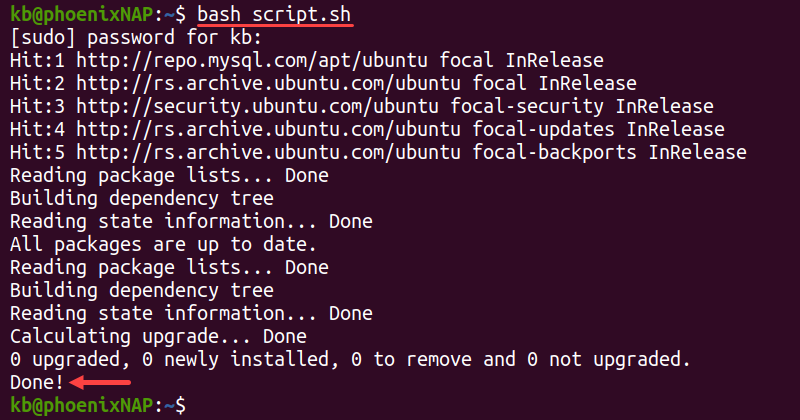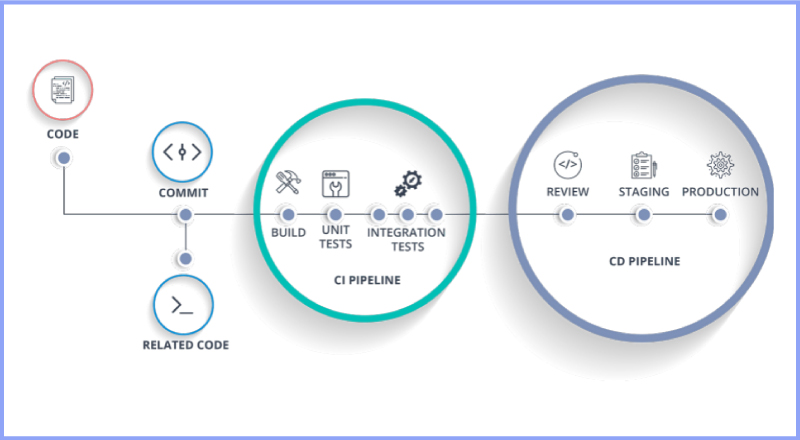Introduction: The Unsung Hero of Linux Automation
In the world of modern IT, dominated by complex orchestration tools and high-level programming languages, the humble Bash script remains an indispensable tool for anyone working with Linux. From simple task automation to complex system administration and robust DevOps pipelines, Bash scripting is the powerful glue that holds countless operations together. Whether you are a seasoned system administrator managing a fleet of Linux servers, a DevOps engineer building CI/CD pipelines, or a developer working on a Linux-based project, mastering Bash is not just a valuable skill—it’s a fundamental one. This guide will take you on a comprehensive journey from the basic building blocks to advanced techniques, empowering you to leverage the full potential of the Linux terminal for efficient and powerful automation. We’ll explore core concepts, practical real-world examples, and best practices that are applicable across a wide range of Linux distributions, including Ubuntu, Debian Linux, Red Hat Linux, and more.
Section 1: The Foundations of Bash Scripting
Before we can automate the world, we must understand the basics. Bash (Bourne Again SHell) is more than just a command-line interface; it’s a full-fledged scripting language. A Bash script is simply a plain text file containing a series of Linux commands that are executed sequentially by the Bash interpreter. This allows you to chain commands, create logic, and perform tasks that would be tedious to type manually.
The Shebang and Script Execution
Every Bash script should begin with a “shebang” line: #!/bin/bash. This line tells the operating system which interpreter to use to execute the script. While other shells exist (like sh, zsh, or fish), specifying /bin/bash ensures your script is run with the Bash shell, providing consistent behavior. To make a script executable, you need to set the correct file permissions using the chmod command. For example: chmod +x your_script.sh.
Variables and Command Substitution
Variables are the cornerstone of any programming language, and Bash is no exception. You can store data in variables to be reused throughout your script. Bash variables are untyped and are declared by simple assignment (e.g., GREETING="Hello, World"). To access the value of a variable, you prefix its name with a dollar sign ($), like echo $GREETING.
Command substitution is a powerful feature that allows you to capture the output of a command and store it in a variable. This is done by enclosing the command in $(...). This is fundamental for creating dynamic scripts that react to the current state of the system.
#!/bin/bash
# This is a simple introductory script.
# 1. Using a simple variable
GREETING="Welcome to the world of Bash Scripting!"
echo $GREETING
# 2. Using command substitution to get the current user and hostname
CURRENT_USER=$(whoami)
SERVER_HOSTNAME=$(hostname)
# 3. Printing a dynamic message
echo "You are currently logged in as '$CURRENT_USER' on the machine '$SERVER_HOSTNAME'."
# 4. Accessing a built-in environment variable
echo "Your home directory is: $HOME"Section 2: Control Structures for Intelligent Automation
Static scripts that only run commands in order are useful, but the real power of Bash scripting comes from its ability to implement logic. Control structures like conditionals and loops allow your scripts to make decisions, repeat actions, and adapt to different situations, forming the core of any meaningful Linux automation task.





Conditional Logic: If-Else and Case Statements
Conditional statements allow your script to perform different actions based on whether a condition is true or false. The most common structure is the if-elif-else block. The condition is typically a test command enclosed in square brackets [ ... ] or double square brackets [[ ... ]], the latter being more modern and powerful.
For scenarios with multiple distinct choices, a case statement can be cleaner and more readable than a long chain of if-elif statements. It compares a variable against several patterns and executes the code block associated with the first matching pattern.
Loops and Functions for Repetitive Tasks
Loops are used to execute a block of code multiple times. The for loop is perfect for iterating over a list of items (like files, servers, or users), while the while loop continues as long as a certain condition remains true. Functions allow you to group a set of commands into a reusable block, making your scripts more modular, readable, and easier to maintain. This is a critical practice in any form of Linux programming or system administration scripting.
Practical Example: Service Health Check Script
Here is a practical script that encapsulates these concepts. It defines a function to check the status of a system service (like a Nginx or Apache web server) and attempts to restart it if it’s not running. This is a common task in system monitoring and administration on any Linux server.
#!/bin/bash
# A script to check the status of a service and restart it if it's not active.
# The service to check is passed as the first argument to the script.
SERVICE_NAME=$1
LOG_FILE="/var/log/service_monitor.log"
# Function to log messages with a timestamp.
log_message() {
echo "$(date '+%Y-%m-%d %H:%M:%S') - $1" >> "$LOG_FILE"
}
# Check if a service name was provided.
if [ -z "$SERVICE_NAME" ]; then
echo "Usage: $0 <service-name>"
echo "Example: $0 nginx"
exit 1
fi
# Check the service status using systemctl. The '>/dev/null 2>&1' part
# suppresses the command's output so we only care about the exit code.
systemctl is-active --quiet "$SERVICE_NAME"
# The '$?' variable holds the exit code of the last command.
# 0 means success (service is active), non-zero means failure.
if [ $? -ne 0 ]; then
echo "Service '$SERVICE_NAME' is not running. Attempting to restart."
log_message "Service '$SERVICE_NAME' was found inactive. Attempting restart."
# Attempt to restart the service.
systemctl restart "$SERVICE_NAME"
# Verify if the restart was successful.
if [ $? -eq 0 ]; then
echo "Service '$SERVICE_NAME' restarted successfully."
log_message "Service '$SERVICE_NAME' restarted successfully."
else
echo "ERROR: Failed to restart service '$SERVICE_NAME'."
log_message "CRITICAL: Failed to restart service '$SERVICE_NAME'."
fi
else
echo "Service '$SERVICE_NAME' is running correctly."
log_message "Service '$SERVICE_NAME' is active."
fiSection 3: Advanced Techniques for Real-World Scenarios
As your needs grow more complex, you’ll need to employ more advanced techniques. This includes handling user input, robust error checking, and processing text data, which are essential skills for building professional-grade automation scripts for tasks like Linux backup, user management, or software deployment.
Handling Input and Arguments
Scripts become far more flexible when they can accept input. Positional parameters ($1, $2, etc.) allow you to pass arguments to your script from the command line. The special variable $# holds the count of arguments, and $@ represents all arguments as a list. For interactive scripts, the read command can be used to prompt the user for input and store it in a variable.
Robust Error Handling








By default, a Bash script will continue executing even if a command fails. This can lead to disastrous results. To write safer scripts, use the “unofficial strict mode” by setting these options at the top of your script:
set -e: Exit immediately if a command exits with a non-zero status.set -u: Treat unset variables as an error when substituting.set -o pipefail: The return value of a pipeline is the status of the last command to exit with a non-zero status, or zero if no command exited with a non-zero status.
This simple addition dramatically improves the reliability of your Linux automation scripts.
Practical Example: Automated Backup Script
This script demonstrates several advanced concepts. It takes a source directory and a destination directory as arguments, creates a timestamped compressed archive, performs error checking, and cleans up old backups. This is a foundational script for any Linux administration toolkit, useful for backing up data on a Linux file system, perhaps one managed by LVM or RAID.
#!/bin/bash
# A robust script to back up a directory.
set -euo pipefail
# --- Configuration ---
SOURCE_DIR=$1
DEST_DIR=$2
RETENTION_DAYS=7
# --- Argument Validation ---
if [ "$#" -ne 2 ]; then
echo "Error: Invalid number of arguments."
echo "Usage: $0 <source_directory> <destination_directory>"
exit 1
fi
if [ ! -d "$SOURCE_DIR" ]; then
echo "Error: Source directory '$SOURCE_DIR' does not exist."
exit 1
fi
# Create destination directory if it doesn't exist
mkdir -p "$DEST_DIR"
# --- Backup Logic ---
TIMESTAMP=$(date +"%Y-%m-%d_%H-%M-%S")
ARCHIVE_FILE="$DEST_DIR/backup-$TIMESTAMP.tar.gz"
echo "Backing up '$SOURCE_DIR' to '$ARCHIVE_FILE'..."
# Create the compressed archive. The 'tar' command is a staple Linux utility.
tar -czf "$ARCHIVE_FILE" -C "$(dirname "$SOURCE_DIR")" "$(basename "$SOURCE_DIR")"
if [ $? -eq 0 ]; then
echo "Backup created successfully."
else
echo "Error: Backup failed."
exit 1
fi
# --- Cleanup Old Backups ---
echo "Cleaning up backups older than $RETENTION_DAYS days in '$DEST_DIR'..."
# The 'find' command is powerful for file system operations.
find "$DEST_DIR" -type f -name "backup-*.tar.gz" -mtime +$RETENTION_DAYS -exec rm -f {} \;
echo "Cleanup complete."
echo "-----------------"Section 4: Best Practices and Integration with DevOps Tools
Writing a script that works is one thing; writing a clean, maintainable, and secure script is another. Adhering to best practices is crucial, especially in a professional environment where scripts are part of a larger Linux DevOps toolchain involving tools like Ansible, Docker, and Kubernetes.
Writing Idempotent and Portable Scripts








An idempotent script is one that can be run multiple times with the same initial state and will always produce the same end state without causing errors. For example, instead of just creating a directory with mkdir, check if it exists first (mkdir -p does this). This is a core principle in automation. Furthermore, write scripts that can run on different Linux distributions. For example, use conditional logic to check for the existence of apt or yum/dnf before attempting to install packages.
Linting and Security
Always use a linter like shellcheck to analyze your scripts for common bugs, syntax errors, and bad practices. It’s an invaluable tool for improving script quality. From a Linux security perspective, be extremely careful with variables that contain user input to avoid command injection vulnerabilities. Never pass them directly to commands like eval. When handling secrets like API keys or passwords, use secure methods like environment variables or a secrets management tool rather than hardcoding them in the script.
Bash as the “Glue” in Modern Stacks
While Python scripting offers more advanced data structures, Bash excels at orchestrating other command-line tools. In a Docker tutorial, you’ll see docker build and docker run commands orchestrated by a Bash script. In a Kubernetes Linux environment, a script might configure kubectl contexts or apply YAML files. When provisioning an AWS Linux or Azure Linux instance, a Bash script is often used as the “user data” to perform initial setup. It remains the universal language for gluing together the powerful tools that define modern infrastructure.
Conclusion: The Enduring Power of the Shell
Bash scripting is a timeless and essential skill for anyone operating in the Linux ecosystem. It provides a direct, powerful, and universally available method for automating tasks, managing systems, and orchestrating complex workflows. From simple scripts that save you a few keystrokes to sophisticated automation that manages entire fleets of servers, the principles we’ve covered are your foundation for success. By understanding core concepts, embracing control structures, implementing robust error handling, and following best practices, you can transform the Linux terminal from a simple interface into a powerful engine for automation. The next step is to start scripting: identify a repetitive task in your daily workflow and automate it. The more you practice, the more you’ll see opportunities to make your work faster, more reliable, and more efficient with the enduring power of Bash.




